Review of New Spectroscopic Instrumentation for 2017
Spectroscopy
Our annual review of new spectroscopy products introduced at Pittcon, or during the previous year.
Our annual review of new spectroscopy products introduced at Pittcon, or during the previous year.
In this annual review, we present new spectroscopy instruments, components, and accessories, and we assess the underlying trends.
The Pittsburgh Conference (Pittcon) remains an important venue for the introduction of new products, and the majority of the products listed here are from companies we visited at that conference. In addition, vendors are increasingly announcing new products independently of Pittcon; therefore, this review also includes products launched at other conferences or independent of any tradeshow in the last 12 months.
A welcome surprise is the increase in Pittcon attendance compared to last year. Total attendance was reported as 14,144, compared to 12,841 last year. We are pleased to report the increase, and consider it to bode well for Pittcon’s future.
The exposition featured 787 exhibiting companies occupying 1404 booths, somewhat lower than last year despite the higher total attendance. Of these companies, 124 were reported as being first-time exhibitors. Perhaps the increased attendance will persuade more new companies to exhibit in the future, as well. A breakdown and comparison with previous Pittcons is available on the Pittcon website at http://pittcon.org/exhibitor/pittcon-demographics/.
Last year, Pittcon did not present the Editor’s Choice awards that it had presented for many years previously. This year, those prizes were replaced with the Pittcon Today Excellence Awards. Details of the selection process are largely unknown, except for an issued statement that the selection committee consisted of a “blue chip panel of experts” who evaluated the entries based on “ingenuity, creativity, implementation, and outcomes.” Entries were divided into three groups based on corporate sales figures, allowing companies to compete with others of a similar size. There were three awards (gold, silver, and bronze) in each class, for a total of nine awards. We are pleased that one atomic spectroscopy and one mass spectrometry instrument were winners in this competition: Elemission won a silver award for its Mission:Coriosity laser-induced breakdown spectroscopy (LIBS) analyzer and Waters Corporation won a gold award for its Acquity QDa mass detector.
The review that follows is organized by wavelength region or type of spectroscopy (such as Raman, X-ray, and so forth), with accessories, components, and software at the end. We arrange our review to allow readers to compare instruments from different manufacturers, although this process sometimes groups handheld instruments with high-end research tools. The categories used to classify the products are
Atomic spectroscopy
Imaging
Mass spectrometry (MS)
Mid-infrared spectroscopy
Near-infrared (NIR) spectroscopy
Nuclear magnetic resonance (NMR)
Raman spectroscopy
UV-visible spectroscopy
X-ray
Accessories
Components
Software
Categories change from year to year, depending upon trends in the submissions. The core spectroscopy headings are consistent, but “imaging” has been transient. In our taxonomy, “accessories” and “components” are inherently general categories. The dividing line between them is this: “Accessories” (such as a sampling device) are used with an instrument, whereas “components” (such as a laser source or detector) are part of an instrument. The “software” category is focused on software developed independently from the instruments, rather than on software built to drive a particular instrument. The software category also includes products like spectral databases and libraries.
Broad Trends
Three broad themes emerged from this year’s new product review. First, in spite of their age, many of the classic techniques saw activity. For instance, many manufacturers have launched tools for the age-old problem of sample preparation and introduction (grinding and pressing samples) and there were new offerings in inductively coupled plasma (ICP) instruments and Fourier transform infrared (FT-IR) microscopy. There should be little surprise here; many of the problems faced by today’s laboratory workers are the same as those from 20–30 years ago. In spite of exciting developments at the cutting edge, there is plenty of basic chemistry still needing to be done.
Second, although many vendors are marketing instruments similar to those from years past, there is a surge in new software developments. Developments center on two problems: matching the user interface to the problem and lowering sampling barriers. Enlarged databases and new algorithms are combining to provide customized, useful reports. Terrain-following software in microscopy is relieving the problem of focusing on an irregular sample over a large area. And collaboration is being enhanced using video cameras and touch screens to replace single-user eyepieces, allowing local and remote users to tackle problems as a team.
Third, Raman spectroscopy offerings continue to expand. At Pittcon, it seemed every aisle had Raman vendors differentiating their products by size (handheld, portable, or benchtop) and performance. The Raman effect was first observed in 1928, so Raman has had a long development cycle. This was because of some very specific requirements that had to be met to make Raman a commercially viable technique. The most crucial tool has been the laser, and now many vendors provide multiple diode laser solutions in small packages with low power needs. Vendors can take the ingredients-lasers, miniaturized diffraction elements, and multichannel detectors-and combine them in a particular form factor to address a specific market.
There are also a few smaller-scale trends that we see. We noted a trend a few years back toward applications-specific analyzers. While this seems to have slowed, many vendors have noted how their tools combine in certain markets. Instruments targeted to the analysis of gemstones, oil, water, and gases are seen this year.
This year we have also noticed some coupling of different types of instruments. Bruker has combined terahertz and FT-IR spectrometers into a single unit. Thermo Fisher Scientific has a Raman spectrometer specifically engineered to be integrated with other analytical tools. Two or three examples do not a trend make, but this is an area to keep an eye on in the future.
This Year’s Products
In each section of the review, we briefly mention all the products and some salient features. In this discussion, some attempt was made to place similar products with each other rather than strictly alphabetically. In addition, an alphabetical table then provides a summary of all the products in that category.
As in the past, it is inevitable that some categories include products that might arguably be classified elsewhere, especially in regards to accessories, components, and software. Even some hyphenated techniques, such as inductively coupled plasma–mass spectrometry (ICP-MS) could legitimately be listed in either location.
“Imaging” represents a unique challenge. Some imaging instruments (such as Raman imaging instruments) will be found under the corresponding technology. Alternately, readers can search by company name or product category in Table I, which references the headers where the content will be found.

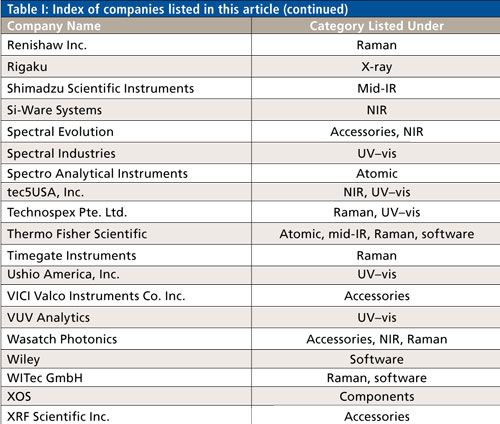
Atomic Spectroscopy
This year in the atomic spectroscopy category (Table II), there are new products from seven companies, of several types.
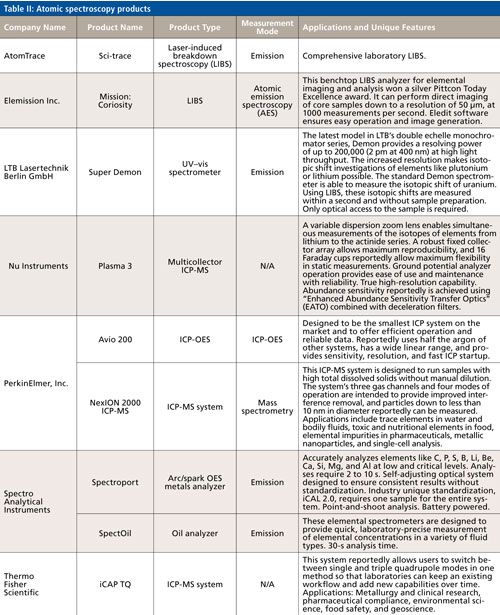
CLICK TABLE TO ENLARGE
LIBS continues to make inroads. Atomtrace has a LIBS instrument with double-pulse DPSS laser and a high-resolution echelle spectrometer with an EMCCD/iCCD detector. Elemission’s Coriosity instrument is the most advanced benchtop LIBS analyzer for elemental imaging and analysis currently on the market, and won a silver Pittcon Today Excellence Award. LTB Lasertechnik’s double echelle monochromator, ideal for use with LIBS, provides increased resolution.
Four new plasma spectrochemistry instruments were launched this year. PerkinElmer has the smallest ICP instrument on the market, with patented Flat Plate plasma technology that reportedly uses half as much argon as other systems do. PerkinElmer also introduced the NexION 2000 ICP-MS system, which is designed to handle high total dissolved solids as well as high- and low-level elements in a single sample. Thermo Fisher Scientific has launched a triple-quadrupole ICP-MS system. This system allows users to easily switch between single- and triple-quadrupole modes in one method so that laboratories can keep their existing workflow as well as add new capabilities over time. Nu Instruments launched its third-generation multicollector ICP-MS (MC-ICP-MS) instrument. A new torch box design in this instrument allows easy connection of a wide range of sample introduction devices, and an additional lens element can be inserted to improve abundance sensitivity performance.
The trend to miniaturized systems also continues. Spectro’s handheld arc/spark optical emission spectroscopy (OES) metals analyzer is designed to accurately analyze elements like C, P, S, B, Li, Be, Ca, Si, Mg, and Al at low and critical levels and reportedly is as fast as a handheld X-ray fluorescence (XRF) instrument. Spectro also provides an oil analyzer based on the same principles.
Imaging
Many imaging instruments (Table III) will be found under the corresponding technology. This section presents two imaging instruments which, for various reasons, were not placed elsewhere.
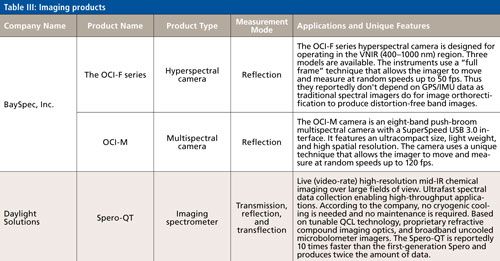
CLICK TABLE TO ENLARGE
Bayspec presents two multispectral cameras. One operates in the visible–NIR spectral region; the other uses “pushbroom” technology.
Daylight Solutions imaging spectrometer is designed to provide ultrafast spectral data collection based on tunable quantum cascade laser technology, enabling high-throughput applications without cryogenic cooling, which means only minimum maintenance is required.
Mass Spectrometry
This year we were surprised at the increase in the number of companies exhibiting mass spectrometers or MS-based analyzers compared to last year. Increased sensitivity was targeted by several vendors in the category (Table IV), but the most prevalent trend seemed to revolve around compactness. With the high-end market reasonably saturated, compactness offers a point of entry for new players, with tighter application-specific targeting.
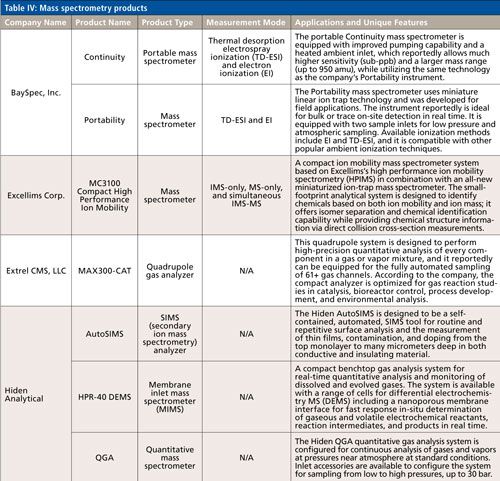
CLICK TABLE TO ENLARGE
Bayspec has two new portable mass spectrometers. One uses miniature linear ion trap technology with higher sensitivity; the other is a lighter-weight version for easier use in the field. Hiden has a self-contained, automated, secondary ion mass spectrometry (SIMS) tool for routine and repetitive surface analysis.
Extrel has a quadrupole mass spectrometry–based gas analyzer. The use of ion mobility technology enables the Excellims instrument’s use at atmospheric pressure.
Mid-IR
In mid-IR (Table V), process monitoring was the target of several vendors. This group of offerings includes a new sensitive gas detection system from Gasera; in addition to general-purpose gas analyzers, Gasera also has a gas analyzer for real-time monitoring of trace-level formaldehyde at extremely low concentrations using built-in automated gas exchange and a quantum cascade laser-an exciting new development. California Analytical Instruments demonstrates a FT-IR gas analyzer that is a versatile instrument and can measure more than 40 gases simultaneously without using liquid nitrogen. Keit has the newest version of a rugged, vibration-tolerant FT-IR spectrometer made for monitoring industrial processes in situ and can be mounted directly onto, or in line with, manufacturing equipment.
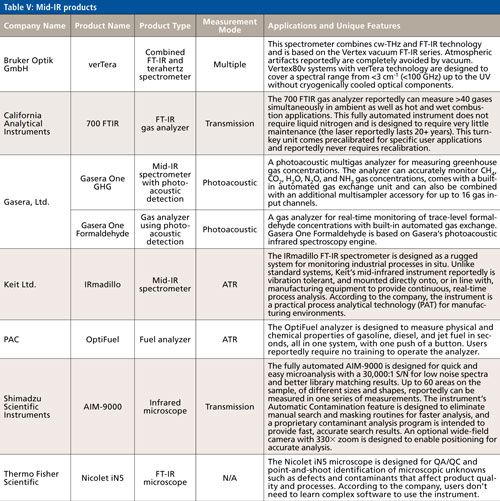
CLICK TABLE TO ENLARGE
In spite of the surge in Raman spectroscopy, the FT-IR microscope still remains a solid and important tool for basic analytical work. IR microscopy was addressed for both basic and advanced users this year. Thermo Fisher Scientific approached the most basic users with the Nicolet iN5 microscope, which has point-and-shoot simplicity. This feature enables fast identification of microscopic unknowns such as defects and contaminants that affect product quality and processes. Shimadzu has a fully automated IR microscope that is designed to perform all steps in microanalysis quickly and easily with a 30,000:1 signal-to-noise ratio (S/N), yielding low-noise spectra for even the smallest contaminants. Daylight Solutions showed an updated quantum cascade laser (QCL) microscope.
Some manufacturers are showing combined technologies, as mentioned in our discussion of trends. Bruker has a combined FT-IR and terahertz spectrometer. In this system, atmospheric artifacts are completely avoided by vacuum systems, enabling coverage from <3 cm-1 (<100 GHz) up to the UV region without cryogenic cooling.
PAC provides a rapid fuel analyzer for gasoline, diesel, and aviation fuel.
NIR
This year, compact benchtop and handheld analyzers took center stage in the NIR category (Table VI).
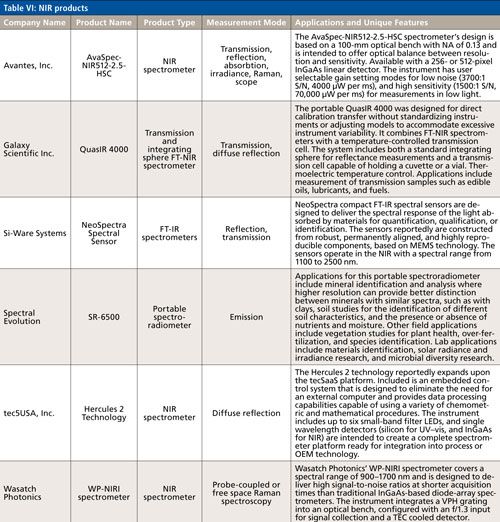
CLICK TABLE TO ENLARGE
Galaxy Scientific is offering a portable transmission and integrating sphere FT-NIR instrument that offers portability combined with high spectroscopic performance for direct calibration transfer without the frustration of standardizing instruments.
Si-Ware Systems introduced a solid-state FT-IR NIR new compact benchtop spectrometer based on microelectromechanical systems (MEMS) technology.
Spectral Evolution has an ultrahigh-resolution portable spectroradiometer with a spectral range of 350–2500 nm. Its spectral resolution is 1.5 nm at 700 nm, 3.0 nm at 1500 nm, and 3.8 nm at 2100 nm.
A new NIR benchtop spectrometer from tec5USA expands upon the previous platform, including embedded control that eliminates the need for an external computer.
Avantes has a compact benchtop instrument with a new linear array InGaAs detector system based on a 100-mm optical bench with a numerical aperture (NA) of 0.13, offering optical balance between resolution and sensitivity.
NMR
Recent years had seen a number of vendors touting new benchtop NMR units. This year, only Magritek announced anything new in this arena, and other vendors did not even show NMR instruments at Pittcon. Whether this is a trend or simply a slow-down remains to be seen. See Table VII for the details.

CLICK TABLE TO ENLARGE
Raman
Raman spectroscopy (Table VIII) remains an area of considerable growth and change. Developments were visible around both the small form factor (AcuTech, Metrohm) and benchtop systems (WITec, Bruker). The availability of new lasers, spectrographs, and detectors has allowed size, sensitivity, and speed to be tuned for specific applications, from raw material identification to ultrafast imaging. Thermo Fisher Scientific offered a compact Raman system designed to hyphenated with tools such as X-ray photoelectron spectroscopy (XPS) or rheometry.
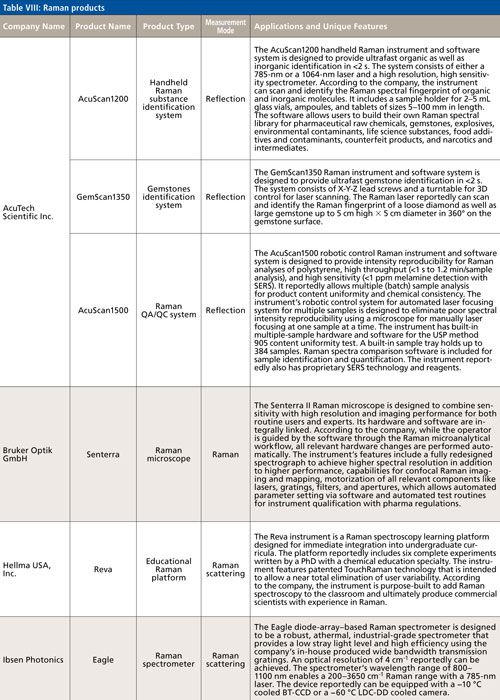
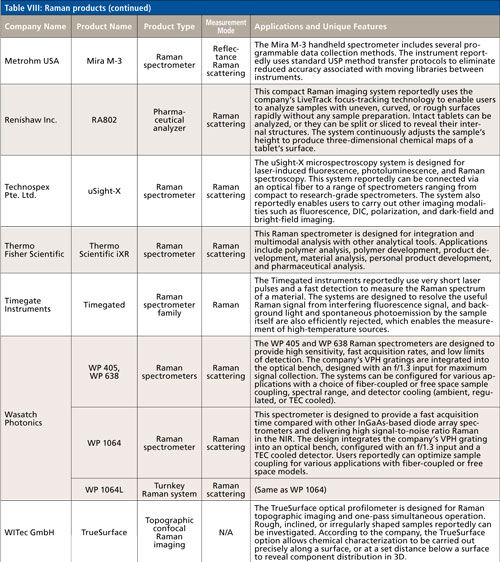
CLICK TABLE TO ENLARGE
Software enables an instrument to conform to the target markets. The simplest-raw material identification-powers handhelds in loading dock situations. High-end imaging is being augmented with 3-D viewing software and terrain-following image software (WITec), which negates the need to stop and autofocus at each point. This approach has removed a significant barrier; now, the sample needs not be perfectly smooth or level.
We provide some highlights of the individual instruments below.
Acutech has a general-purpose Raman spectrometer as well as a specialized version for gems and an automated version that works under robotic control.
Bruker Optik has a Raman microscope designed to provide excellent sensitivity with high resolution and state-of-the-art imaging performance.
Hellma is providing an educational package containing a Raman spectrometer and several lessons to help students learn about Raman spectroscopy.
Ibsen provides a diode-array Raman spectrometer based on its UV–vis spectral bench.
Metrohm’s Mira M-3 brings greater control to a handheld instrument through new programmable data collection methods and standard USP method transfer protocols for libraries.
Renishaw shows a pharmaceutical analyzer with focus-tracking technology designed to enable users to analyze samples with uneven, curved, or rough surfaces.
Technospex’s microspectroscopy system is multifunctional. It is designed for laser-induced fluorescence, photoluminescence, and Raman spectroscopy.
Thermo Fisher Scientific’s Raman spectrometer was developed specifically for integration with other analytical tools (such as rheology or XPS), for multimodal analysis, polymer analysis, polymer development, personal care product development, and pharmaceutical applications.
Timegate Instrument’s Raman system uses very short laser pulses and fast detection. This system rejects background light and spontaneous photoemission from the sample, which enables the measurement of high-temperature sources.
Wasatch Photonics provides a series of Raman spectrometers based on the use of the volume phase holographic (VPH) gratings.
WITec’s TrueSurface module for topographic confocal Raman imaging enhances the power and user-friendliness of confocal Raman microscopes. Raman topographic imaging now features one-pass simultaneous operation. Rough, inclined, or irregularly shaped samples can be investigated with the same ease as standard samples.
UV–vis
A key theme for UV–vis spectroscopy (Table IX) this year continues to be minimization of sample volume and the overall spectrometer. This minimization of the instrument is lowering the cost of such systems and providing new functionality in tiny spectrometers: Most include Raman and fluorescence capabilities in addition to UV–vis. Additionally, microvolume UV–vis continues to be a theme.

CLICK TABLE TO ENLARGE
Below are some of the highlights of the this year’s UV–vis offerings.
Avantes combines an ultralow-stray-light design, a thermoelectric-cooled back-thinned detector, and a new electronics board to provide a device capable of resolution down to 0.2 nm without sacrificing sensitivity.
Distek eliminates sampling by measuring directly in the dissolution vessel, thus also eliminating problematic filters, tubing, and pumps used in conventional sampling.
Pultton uses a new technology that does not require movement of the measuring arm. Instead, the sample is placed directly on the “Integrated Optic Path.”
Hach’s new DR6000 UV–vis spectrophotometer is designed for both routine laboratory tasks and demanding photometry applications.
Ibsen Photonics’s vis–NIR instrument seeks to balance compact size with the high performance of a unique transmission grating technology. A robust, athermal, industrial-grade diode-array–based spectrometer, well-suited for Raman spectroscopy, it can operate under demanding environmental conditions.
Spectral Industries has the first echelle spectrometer ready for industrial applications that combines the advantages of an echelle spectrometer-high bandwidth and low resolution-with compact size, f/2 design, and high robustness. The system also is equipped with a deep-UV-sensitive CMOS camera.
The instrument from tec5USA features rugged process-ready spectrometers and light sources, available as separate modular units, or housed in a singular IP65 enclosure.
Technospex’s instrument is designed for UV–vis–NIR reflectance, transmittance, and absorbance measurement at the microscopic level. This system can be equipped with Raman, fluorescence, dark field, bright field, polarization functions for multimodality imaging.
Ushio has a compact laboratory research device that dramatically improves the efficiency of experiments. This analytical tool allows for quick concentration measurement and detection of protein, nitrite ion concentration, heavy metals, endocrine disruptors, and DNA through colorimetric assays or reagents.
VUV Analytics has a next-generation vacuum ultraviolet (VUV) benchtop spectrometer. Used as a gas chromatography (GC) detector, this instrument provides the easy identification and quantitation of compounds without the need for chromatographic baseline resolution, including coeluted analytes and structural isomers.
X-ray
The vast majority of announcements for new X-ray devices (Table X) called out “benchtop” as a feature, in both diffraction and fluorescence modes.
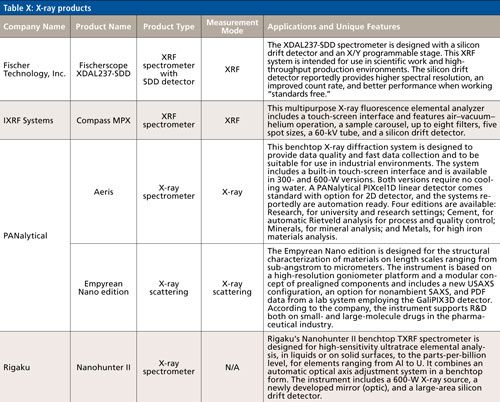
CLICK TABLE TO ENLARGE
Fischer Technology has an X-ray fluorescence (XRF) spectrometer with a silicon drift detector (SDD) and higher resolution.
The instrument from iXRF has a new touch-screen interface as well as high-end XRF features.
PANalytical’s X-ray spectrometer is a new benchtop X-ray diffraction system designed to provide high data quality and speed of data collection, an intuitive interface, and a built-in touchscreen.
Rigaku has an X-ray spectrometer designed for high-sensitivity ultratrace elemental analysis, in liquids or on solid surfaces, to the parts-per-billion (ppb) level, detecting elements ranging from Al to U.
Software
Software (Table XI) touches all aspects of the analytical lab data stream: system validation, and data collection, processing, analysis, and reporting. Additionally, networking and data management (in laboratory information management systems, or LIMS) are concerns. Many new products announced in 2017 touch on these aspects. Surprisingly, we did not see any new validation products, although recent actions by the U.S. Food and Drug Administration (FDA) indicate a tightening of enforcement. Within this diversity, two important themes are evolving. First, customer problems are being addressed with features such as terrain-following software, improved searching of mixtures, and user friendly workflow-development (macros).

CLICK TABLE TO ENLARGE
Second, collaboration is being enhanced through video capture and networking. These features permit remote control of an instrument from a home office or enable multiple scientists to view and discuss data live, not just as part of a report. Our experience in dealing with customers worldwide indicates remote control capability is growing in importance, as problems arise in a location remote from the core analytical expertise.
ACD/Labs has an informatics system that enables organizations to establish effective impurity control strategies based on assembled analytical and chemical information, in a single environment.
AtomTrace offers spectral processing software built so that users can create a spectra-processing algorithm by connecting individual functional blocks in a graphical user interface. This way, even complicated algorithms can be clear and easily editable and manageable.
Autoscribe Informatics has a LIMS that has a built-in graphical configuration tool that allows every screen in a workflow to be modified to the user’s exact needs without any software coding knowledge, simplifying LIMS configuration.
Bruker Optik GmbH offers web-based networking software that can set up, administer, and control a network of Bruker FT-NIR instruments from anywhere in the world.
Cerno Bioscience has developed software to correct measured mass spectra to theoretically correct line shapes, for simpler and more accurate identification.
Eurofins provides services to assist new users in calibration modeling software.
Fiveash Data Management has a new, faster search program to identify materials from their spectra.
Hellma’s offering provides software control for the Hellma fiber multiplexers.
Horiba Scientific’s Raman navigation software is designed to handle a range of samples, such as minerals, semiconductors, metal samples, and semitransparent samples. It can also be used on medicine and polymer samples.
Thermo Fisher Scientific has the Grams suite of spectral analysis software for visualizing, processing, and managing spectroscopy data.
Wiley has an updated library of mass spectra of drugs containing 25,114 mass spectra and 19,665 unique compounds predominantly classified as novel psychoactive substances (NPS). It contains more than 30 subcategories of compounds present such as amphetamines, cannabinoids, and benzodiazepines.
WITec’s Suite Five is an intuitive operating system for all WITec microscopes. It includes a powerful software environment for data acquisition, evaluation, and processing of even large data volumes and 3D scans.
Accessories
Most accessories (Table XII) announced this year represent evolutions in design rather than wholly new approaches, probably responding to specific customer requests. Big samples are addressed for FT-IR by lifting the sampling plane out of the spectrometer (PIKE), and multiple innovations around sample introduction for ICP (Glass Expansion) addressed temperature of introduction and cleaning. It was very interesting that the hoary old problem of solid sample preparation (grinding and pellet formation) was addressed by multiple vendors, showing that in spite of massive technical revolutions like attenuated total reflectance (ATR), grinding and pressing remains important. And speaking of ATR, recent years saw multiple diamond ATR accessories being introduced whereas this year’s offerings are quiet on this front. Below are highlights of each vendor’s offering.
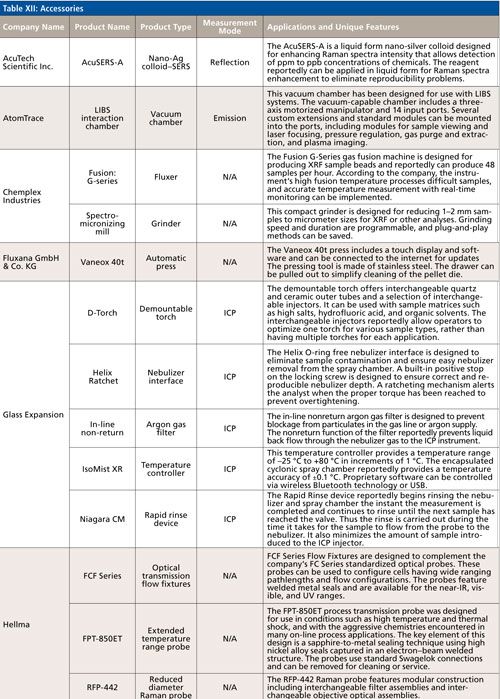
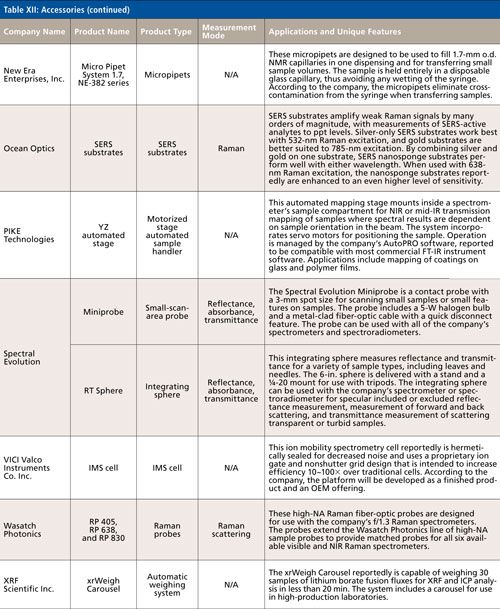
CLICK TABLE TO ENLARGE
Acutech provides nanoparticles for surface-enhanced Raman spectroscopy (SERS) in a liquid base.
For workflow easement, AtomTrace offers a versatile vacuum-capable chamber designed for LIBS systems. Several features are designed to faciliate workflow, including a three-axis motorized manipulator and 14 input ports, along with various custom extensions or modules.
Chemplex offers an advanced gas fusion machine for XRF sample beads, capable of producing 48 samples an hour.
Fluxana provides an automatic press that has a touch display with easy-to-use software as well as the possibility of a webserver connection. It is designed to simplify cleaning and to accelerate sample preparation.
Glass Expansion has several new products this year for ICP analysis: an improved demountable torch, an O-ring-free nebulizer, an argon filter, and a gas temperature regulator.
Hellma has three new fiber probes available: a ruggedized standard probe, a high-temperature probe, and a reduced-diameter probe.
New Era offers a micropipet system that prevents sample cross-contamination from carryover.
Ocean Optics is improving its SERS systems by offering prepared substrates.
PIKE has an extended-height specular reflection accessory that enables reflection to occur at angles up to 10 degrees, a low-volume heated gas cell, and an automated stage.
Spectral Evolution has a mini-probe and an integrating sphere for diffuse reflection measurements. Thermo offers an FT-IR microscope with “point and shoot” capability.
Valco (VICI) provides a hermetically sealed cell for its ion mobility spectrometer.
Wasatch Photonics provides Raman fiber probes to match its instruments, thus providing optimum signal characteristics.
XRF Scientific has expanded its automatic weighing capabilities to include a 30-sample carousel.
Components
Several new components (Table XIII) addressed classic needs, with offerings such as customizable blaze gratings and calibration sources. The surge of new lasers seen in 2016 did not repeat, with only a few novel lasers being introduced. This year, optical components seem to predominate.
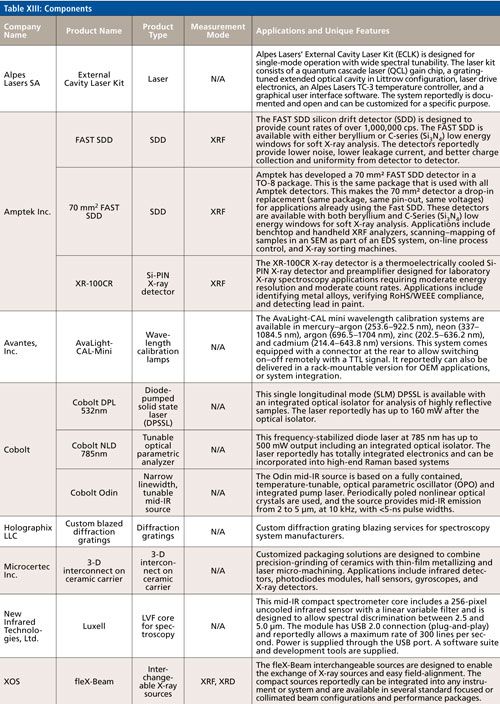
CLICK TABLE TO ENLARGE
The line of external cavity laser kits from Alpes Lasers is designed for single-mode operation with wide spectral tunability.
Avantes has wavelength calibration systems with mercury-argon, neon, argon, zinc, and cadmium versions.
Cobolt shows off two lasers: a high-performance frequency-stabilized diode laser at 405nm with power up to 30mW, and a high-performance, ultracompact, Q-switched diod-pumped solid-state laser (DPSSL) at 1064 nm, with a combination of high pulse repetition rates (>7 kHz), high average power (up to 1 W), and short pulse lengths (<5 ns).
Holographix now offers custom blazed diffraction gratings.
Microcertec has a new 3D (2D–1D) packaging method.
New Infrared Technologies has a mid-IR compact spectrometer whose core includes a 256-pixel uncooled infrared sensor with a linear variable filter.
Amptek has a series of new X-ray detectors, with improved quality.
XOS has a system for interchanging X-ray sources.
Howard Mark serves on the Editorial Advisory Board of Spectroscopy and is a regular coauthor of the “Chemometrics in Spectroscopy” column. He also runs a consulting service, Mark Electronics, in Suffern, New York. Mike Bradley also serves on Spectroscopy’s Editorial Advisory Board and is a Senior Manager, Product Applications at Thermo Fisher Scientific in Madison, Wisconsin. Direct correspondence to hlmark@nearinfrared.com
Erratum
The online version of this article has been updated to address an omission in the print version. Table II and the section on atomic spectroscopy now include information about PerkinElmer’s NexION 2000 ICP-MS instrument, which was inadvertently left out of the original print version of this article.

New Raman Spectroscopy Method Enhances Real-Time Monitoring Across Fermentation Processes
April 15th 2025Researchers at Delft University of Technology have developed a novel method using single compound spectra to enhance the transferability and accuracy of Raman spectroscopy models for real-time fermentation monitoring.
New Multi-Spectroscopic System Enhances Cultural Heritage Analysis
April 2nd 2025A new study published in Talanta introduces SYSPECTRAL, a portable multi-spectroscopic system that can conduct non-invasive, in situ chemical analysis of cultural heritage materials by integrating LIBS, LIF, Raman, and reflectance spectroscopy into a single compact device.